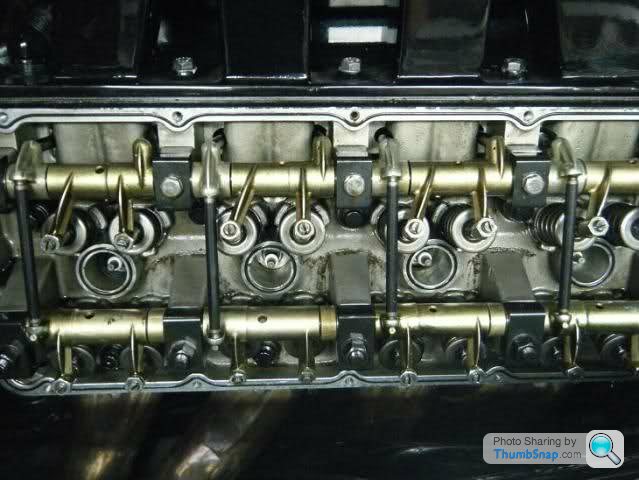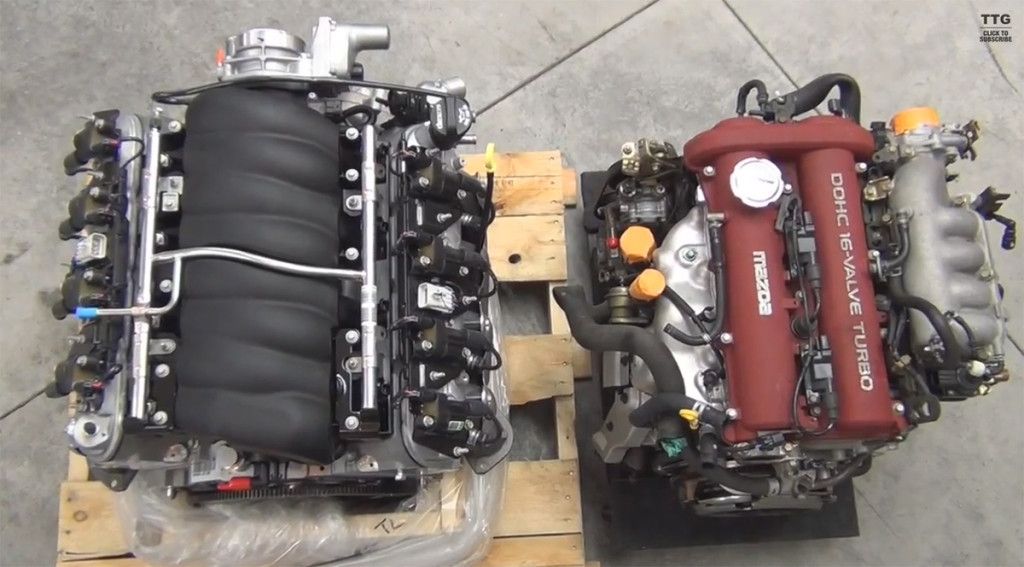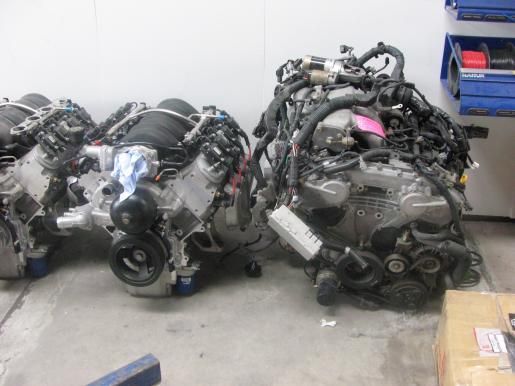Potentially Stupid Question - Overhead Cam Engines
Discussion
Ozzie Osmond said:
Mr2Mike said:
AKAIK F1 engines have pneumatic valve springs, but the valves are still actuated by camshafts.
I think it's all about getting the valves quickly and firmly closed without the "bounce" or "float" that can tend to occur due to a metal spring.1) No fatigue limit (conventional metal springs are rather obviously "twisted" every time they are compressed, those fatigue cycles quickly add up, and result in cracking and failure)
2) You can tailor the spring force verses displacement. By carefully configuring system air volume, and air paths, you can have a non linear valve spring system. Whilst possible with metal springs, it involves complex winding of the springs. hence you can have a high nose load, but a much lower base circle load.
3) The fundamental frequency of the springing medium can be tuned and hence spring shuffle and oscillation can be avoided within the operating speed range. Aggressive cam ramps can be used without exciting the system
4) Virtually limitless lift envelope (no coils to go "coil bound)
5) During development, spring load can be easily changed (by changing system pressure) and it can even be dynamically changed (vs engine speed for example)
The downsides of course are complex sealing requirement and a short seal life as a result, and the necessity to ensure system pressure is available before the engine is started
skyrover said:
hp per litre is irrelevant...
And yet funnily, as someone who develops engines, all my OEM clients have bhp/litre as one of the highest priorities for their development targets..........(because a high specific output engine also results in the highest economy/performance ratio, which is what really matters these days)
Max_Torque said:
skyrover said:
hp per litre is irrelevant...
And yet funnily, as someone who develops engines, all my OEM clients have bhp/litre as one of the highest priorities for their development targets..........(because a high specific output engine also results in the highest economy/performance ratio, which is what really matters these days)
Some countries legislate on displacement, regardless of how usefull it is as a measure of engine performance
Max_Torque said:
Sorry, but B*ll*cks!
The 455bhp/620Nm LS V8 is 6.2l, that's a reasonable 100Nm/l (ok, but nothing special these days) and a lame 73bhp/l (awful)
Also, whilst they are compact for a 6.2l V8, they are NOT smaller/lighter than a small capacity euro V6 engine
However, they are a very cheap, robust way to 455bhp, but come with massive economy penalties which simply are not viable in the European market (hence no European OEM uses one)
What small capacity european V6 makes 460 bhp, 450 lb-ft, and does 30 US mpg (35 uk mpg)? The 455bhp/620Nm LS V8 is 6.2l, that's a reasonable 100Nm/l (ok, but nothing special these days) and a lame 73bhp/l (awful)
Also, whilst they are compact for a 6.2l V8, they are NOT smaller/lighter than a small capacity euro V6 engine
However, they are a very cheap, robust way to 455bhp, but come with massive economy penalties which simply are not viable in the European market (hence no European OEM uses one)
Edit - and don't say a turbo.
kambites said:
amusingduck said:
Does anyone know whether they made an LS engine with more than 2 valves per cylinder?
If not, why not?
I think there was briefly a DOHC 32 valve LS V8. As far as I know there's never been more than 2 valves per cylinder on the push-rod engines, I suppose it's just too hard to make paths for 32 pushrods through the block and head; I don't know whether you could actuate 2 valves from one pushrod somehow. If not, why not?
Chevy LS 32v conversion, with 16 push rods.

tumble dryer said:
iva cosworth said:
Sidevalve and overhead valve engines are just old tech. The OHC became mainstream from the 1970s onwards.
As above. Nobody actually thought about another way around the problem, cos it wasn't one at the time. Which makes me think, what else has seen such an engineering step-change of thought? wankels... Others??
1933 Aston Martin single overhead cam

1932 Lagonda 2 litre twin overhead cam engine

1953 Aston Martin DB2 twin overhead cam engine.
Edited by RichB on Friday 31st July 08:32
amusingduck said:
Does anyone know whether they made an LS engine with more than 2 valves per cylinder?
If not, why not?
For the LT1, the engine before the LS series, there where some 4v setups. One still used pushrods. And the other was found in the C4 ZR-1 part developed by Lotus.If not, why not?
But adding DOHC to an LS simply makes it taller, wider, longer, heavier and with a higher centre of gravity. As a rule it's just easier to up the displacement or add boost and get just as good or better gains without the same downsides as DOHC. In the aftermarket where emissions, mpg and tractability are less of a concern, there simply isn't a worthwhile need to make it a multi-valve engine.
Max_Torque said:
Sorry, but B*ll*cks!
The 455bhp/620Nm LS V8 is 6.2l, that's a reasonable 100Nm/l (ok, but nothing special these days) and a lame 73bhp/l (awful)
Also, whilst they are compact for a 6.2l V8, they are NOT smaller/lighter than a small capacity euro V6 engine
However, they are a very cheap, robust way to 455bhp, but come with massive economy penalties which simply are not viable in the European market (hence no European OEM uses one)
Who frankly gives a flying smeg about bhp/litre. It's total power output that matters. And 450bhp beats anything 200-250bhp.The 455bhp/620Nm LS V8 is 6.2l, that's a reasonable 100Nm/l (ok, but nothing special these days) and a lame 73bhp/l (awful)
Also, whilst they are compact for a 6.2l V8, they are NOT smaller/lighter than a small capacity euro V6 engine
However, they are a very cheap, robust way to 455bhp, but come with massive economy penalties which simply are not viable in the European market (hence no European OEM uses one)
As for fuel, well I posted this up years ago, that a Camaro has a similar EPA mpg rating as the BMW 335i did, despite weighing more and making 100bhp more than the BMW! If that's an economy penalty, then I'll take it every day of the week and twice on Sundays.

But that was a few years back, so here's an update:

Similar mpg from all. But wow that twin turbo DOHC unit from BMW is massively down on power compared to the OHV engines.
As for size, I think you'll find you are wrong about sizing.
Here is an LS and a Lexus 1UZ-FE, quite a size difference:

Ok the 1UZ is a V8, so how about compared to a Mazda inline 4 engine (from an MX-5). The LS is hardly any bigger:

Ok, so I said V6. Well how about this. LS2 (6.0 litre with 420hp) and a Nissan VQ35 V6 (3.5 litre 240-275hp):

300bhp/ton said:
Max_Torque said:
Sorry, but B*ll*cks!
The 455bhp/620Nm LS V8 is 6.2l, that's a reasonable 100Nm/l (ok, but nothing special these days) and a lame 73bhp/l (awful)
Also, whilst they are compact for a 6.2l V8, they are NOT smaller/lighter than a small capacity euro V6 engine
However, they are a very cheap, robust way to 455bhp, but come with massive economy penalties which simply are not viable in the European market (hence no European OEM uses one)
Who frankly gives a flying smeg about bhp/litre. It's total power output that matters. And 450bhp beats anything 200-250bhp.The 455bhp/620Nm LS V8 is 6.2l, that's a reasonable 100Nm/l (ok, but nothing special these days) and a lame 73bhp/l (awful)
Also, whilst they are compact for a 6.2l V8, they are NOT smaller/lighter than a small capacity euro V6 engine
However, they are a very cheap, robust way to 455bhp, but come with massive economy penalties which simply are not viable in the European market (hence no European OEM uses one)
As for fuel, well I posted this up years ago, that a Camaro has a similar EPA mpg rating as the BMW 335i did, despite weighing more and making 100bhp more than the BMW! If that's an economy penalty, then I'll take it every day of the week and twice on Sundays.

But that was a few years back, so here's an update:

Similar mpg from all. But wow that twin turbo DOHC unit from BMW is massively down on power compared to the OHV engines.
As for size, I think you'll find you are wrong about sizing.
Here is an LS and a Lexus 1UZ-FE, quite a size difference:

Ok the 1UZ is a V8, so how about compared to a Mazda inline 4 engine (from an MX-5). The LS is hardly any bigger:

Ok, so I said V6. Well how about this. LS2 (6.0 litre with 420hp) and a Nissan VQ35 V6 (3.5 litre 240-275hp):

(how many OEMs did you meet last week to talk about future powertrains btw??)
oh, and here's a couple of pictures with about as much relevance as yours:


Edited by anonymous-user on Friday 31st July 21:31
Max_Torque said:
Oh yes, of course silly me, i should have realised i was wrong and i will hand in my notice on monday after 25 years of engine development experience as it's quite clear that you have all the answers........
(how many OEMs did you meet last week to talk about future powertrains btw??)
Your arrogance isn't doing any favours IMO(how many OEMs did you meet last week to talk about future powertrains btw??)
Nor have you put up a convincing counter argument other than "I know better so shut up"
skyrover said:
Max_Torque said:
Oh yes, of course silly me, i should have realised i was wrong and i will hand in my notice on monday after 25 years of engine development experience as it's quite clear that you have all the answers........
(how many OEMs did you meet last week to talk about future powertrains btw??)
Your arrogance isn't doing any favours IMO(how many OEMs did you meet last week to talk about future powertrains btw??)
Nor have you put up a convincing counter argument other than "I know better so shut up"
Economy: Comparing a bmw 435i (at 23mpg US) and a Camaro at 19mpg. Thats 20% worse economy! 20%! My customers are asking about saving 0.5% here and there! If you made a car that missed it's economy targets by 20% you would be (rightly) fired, and the project would get binned! Now i know to "people on the net" that the number 19 is close to the number 23, but look, over 100miles, the Camaro uses 1 whole gallon more fuel!
Size: Stop posting pictures of completely undressed US V8s against fully dressed euro engines! It's no surprise that a v8 without manifolds, no loom and the FEAD removed is small. If you did the same to a 4cyl engine it would also be very small!
Weight: same story, without proper mass numbers (and i don't mean random stuff from Google) then you can't compare anything.
Power: Taking the example given, the BMW 435i is deliberately power limited by BMW to avoid treading on the toes of the M3/M4. With pretty much identical engines, they make well over 400bhp and result in a vehicle performance that is very similar to the Hicap Camaro (i suspect, with more torque at lower rpm, an M3 is actually significantly quicker btw)
Reality: Just about no european car uses a low tune large capacity V8. Outside of some niche low volume applications they don't use these engines simply because they do not suit the target attributes necessary to sell a car in Europe. When you consider the engineering resources of say BMW or MERC or Audi, do you think they would struggle to make a better large capacity engine than the Yanks?
So in Europe, in the real world, those big Yank V8s are dinosaurs, and in fact, so are the mid capacity turbo engines the European OEMS are currently using. Powertrain electrification has now such a momentum behind it's development, in less than 10 years, large capacity ICEs are going to be extinct in Europe...........
Sounds like even more reason to buy a push rod V8 to me. What you fail to mention is the customers who buy the cars you are talking about don't give a stuff about cars. They just want cheap and reliable, so do the manufacturers themselves. Cheaper the better! You may as well be designing the next generation of washing machines.
Edited by anonymous-user on Friday 31st July 23:08
Gassing Station | General Gassing | Top of Page | What's New | My Stuff





